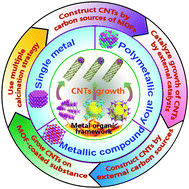A review of recent work on using metal–organic frameworks to grow carbon nanotubes
Abstract
Carbon nanotubes (CNTs) have long been known as a class of one-dimensional carbon nanomaterials with sp2-hybridized structures that can be constructed with a very large length-to-diameter ratio, which is significantly larger than that of any other carbon nanomaterials. It is well known that CNTs exhibit many excellent properties in mechanics, electricity, chemistry, optics, etc., and are widely used in various fields, thus attracting scientists’ attention. In this context, the development of new strategies for optimizing and synthesizing CNTs has far-reaching significance and demand. On the other hand, most metal–organic frameworks (MOFs) are microporous crystals constructed from ordered and uniform metal ions/clusters and organic linkers to obtain crystalline solids with potential porosity. Using MOF materials as precursors, hierarchical CNT-based composite materials, which are difficult to synthesize through the traditional catalyst-assisted chemical vapor deposition method, can be conveniently synthesized by thermal treatment at high temperature. In the process of converting MOFs into CNTs, MOF crystals are used as both catalysts and carbon sources, which are necessary for the growth of CNTs, and they are also used as templates and/or carriers for additional catalysts. Therefore, there are various possibilities for the thermal conversion of MOFs into CNT-based composite materials. In this review, we mainly summarize the two aspects of catalysts and synthetic strategies for MOF-derived CNT-based composite materials. Despite the rapid development in this area, there is still much space for exploration. In order to accurately control the synthesis of CNTs, we should deeply explore the thermal conversion process and mechanism for the conversion of MOFs into CNTs.



 Please wait while we load your content...
Please wait while we load your content...